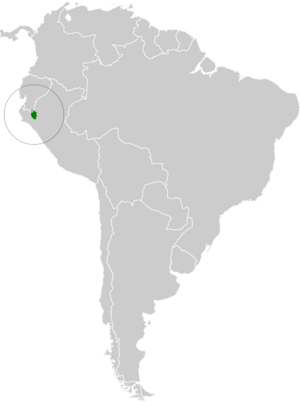Marañón crescentchest facts for kids
Quick facts for kids Marañón crescentchest |
|
|---|---|
| Conservation status | |
| Scientific classification | |
| Genus: |
Melanopareia
|
| Species: |
maranonica
|
 |
|
The Marañón crescentchest (Melanopareia maranonica) is a small, unique bird. It belongs to a special bird family called Melanopareiidae. You can find this bird living in parts of southern Ecuador and northern Peru.
Contents
Meet the Marañón Crescentchest
This bird gets its name from the Marañón River valley, where it mostly lives. It's a fascinating bird with a distinct look.
What Does It Look Like?
The Marañón crescentchest is about 16 cm (6.3 in) long. That's about the length of a regular pencil! A female bird can weigh around 23 g (0.81 oz), which is lighter than a slice of bread.
Male Marañón crescentchests have a black head and neck. Their back and rump are a grayish-olive color. Their chin and throat are white or light cream. Below the throat, they have a wide black band that blends into a chestnut-colored chest. The belly area is a warm, yellowish-brown.
Female birds look quite similar to males. However, their black band below the throat is a bit thinner. Also, the colors on their underparts, from the band down to the tail, are more of a yellowish-brown.
Where Does It Live?
The Marañón crescentchest has a very small home range. It lives mainly in the valley of the Marañón River and its smaller rivers. This area is in northern Peru and just a little bit into Ecuador.
These birds prefer to live at elevations from 200 to 700 m (660 to 2,300 ft) above sea level. They like tropical forests that lose their leaves in the dry season. They also enjoy dry, bushy areas.
What Does It Eat?
Scientists haven't fully studied what the Marañón crescentchest eats. But like many birds, it probably eats insects. It might also snack on seeds and other plant parts.
Sounds and Songs
The Marañón crescentchest has a special song. It's a series of rich notes that sound like "tu tu-tu-tu'tu'tu'tu'tu'tu'tu'tu" [1]. They also make different kinds of calls [2].
Reproduction and Life Cycle
Not much is known about how the Marañón crescentchest raises its young. However, other birds in the Melanopareia family build cup-shaped nests. So, it's likely that the Marañón crescentchest does the same.
Conservation Status
The IUCN (International Union for Conservation of Nature) keeps track of how many animals are left in the wild. They have listed the Marañón crescentchest as "Near Threatened." This means its population is getting smaller.
The bird is not very common in its small habitat. Scientists believe its numbers are going down. This makes it important to protect their homes and ensure they have a safe place to live.


